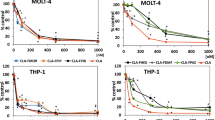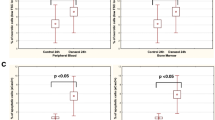Abstract
Extracellular ATP (ATPo) is capable of inducing different events on cells through receptor activation. The effect produced by ATPo was studied in the cell line K562 and its multidrug resistant (MDR) counterpart, Lucena 1. Lower ATPo concentrations (1 mM and 2.5 mM) led to high 3H-thymidine incorporation but no increase in cell number. Similarly, the cell cycle profile indicated an increase of cells in S phase and a decrease in G1 and G2, suggesting that the cells did not duplicate their DNA content. Higher doses of ATP (5 mM and 10 mM), as well as UTP (5 mM) and the P2X7 agonist BzATP, were cytotoxic. However, no expression of P2X7 receptors could be detected by Western Blot nor were the cells permeabilised by ATP, suggesting that pore formation was not involved in cell death. Both ecto-ATPase and ecto-5′-nucleotidase activity could be demonstrated at the surfaces of K562 and Lucena 1 cells, the latter presenting a higher ecto-5′-nucleotidase activity. Adenosine induced cell death at lower concentrations (2.5 mM) on both cell lines. Furthermore, an increased number of dead cells could be observed when 5 mM Adenosine was used compared to the same concentrations of ATPo. It still remains to be elucidated the nature of the receptors involved in the induction of cell death in these cells.
Similar content being viewed by others
References
Burnstock G, Knight GE: Cellular distribution and functions of P2 receptor subtypes in different systems. Int Rev Cytol 240: 31–304, 2004
Chow SC, Kass GE, Orrenius S: Purines and their roles in apoptosis. Neuropharmacol 36: 1149–1156, 1997
Di Virgilio F, Chiozzi P, Ferrari D, Falzoni S, Sanz JM, Morelli A, Torboli M, Bolognesi G, Baricordi OR: Nucleotide receptors: an emerging family of regulatory molecules in blood cells. Blood 97: 587–600, 2001
Coutinho-Silva R, Persechini PM, Bisaggio RC, Perfettini JL, Sá-Neto ACT, Kanellopoulos JM, Motta-Ly I, Dautry-Varsat A, Ojcius DM: P2Z/P2X7 receptor-dependent apoptosis of dendritic cells. Am J Physiol 276: C1139–C1147, 1999
North RA: Molecular physiology of P2X receptors. Physiol Rev 82: 1013–1067, 2002
Ralevic V, Burnstock G: Receptors for purines and pyrimidines. Pharmacol Rev 50: 413–492, 1998
Surprenant A, Rassendren F, Kawashima E, North RA, Buell G: The cytolytic P2Z receptor for extracellular ATP identified as a P2X receptor (P2X7). Science 272: 735–738, 1996
Sanches G, de Alencar LS, Ventura LA: ATP induces proliferation of retinal cells in culture via activation of PKC and extracellular signal-regulated kinase cascade. Int J Dev Neurosci 20: 21–27, 2002
Franke H, Krugel U, Illes P: P2 receptor-mediated proliferative effects on astrocytes in vivo. Glia 28: 190–200, 2002
Neary JT, McCarthy M, Kang Y, Zuniga S: Mitogenic signaling from P1 and P2 purinergic receptors to mitogen-activated protein kinase in human fetal astrocyte cultures. Neurosci Lett 242: 159–162, 1998
Heppel LA, Wang D, Huang N, Gonzalez FA, Ahmed AH, Alfonzo RG, Desheesh M: Extracellular ATP is a mitogen for 3T3, 3T6, A431, DDT1-MF2, BALB/MK, NIE-115, and HFF cells. Ann NY Acad Sci 603: 432–434, 1990
Hou M, Moller S, Edvinsson L, Erlinge D: Cytokines induce upregulation of vascular P2Y(2) receptors and increased mitogenic responses to UTP and ATP. Arterioscler Thromb Vasc Biol 20(9): 2064–2069, 2000
Ikehara S, Pahwa RN, Lunzer DG, Good RA, Modak MJ: Adenosine-5′-triphosphate-(ATP) mediated stimulation and suppression of DNA synthesis in lymphoid cells. I. Characterization of ATP responsive cells in mouse lymphoid organs. J Immunol 127: 1834–1838, 1981
Sabirov RZ, Okada Y: ATP release via anion channels. Purinergic Signalling 1: 311–328, 2005
Bodin P, Burnstock G: Purinergic signalling: ATP release. Neurochem Res 26: 959–969, 2001
Abraham EH, Prat AG, Gerweck L, Seneveratne T, Arceci RJ, Kramer R, Guidotti G, Cantiello HF: The Multidrug Resistance (mdr1) Gene Product Functions as an ATP Channel. Proc Natl Acad Sci USA 90: 312–316, 1993
Juliano RL, Ling V: A surface glycoprotein modulating drug permeability in Chinese hamster ovary cell mutants. Biochim Biophys Acta 455: 152–162, 1976
Ambudkar SV, Kimchi-Sarfaty C, Sauna ZE, Gottesman MM: P-glycoprotein: from genomics to mechanism. Oncogene 22(47): 7468–7485, 2003
Leslie EM, Deeley RG, Cole SPC: Multidrug resistance proteins: role of P-glycoprotein, MRP1, MRP2, and BCRP (ABCG2) in tissue defense. Toxicol Appl Pharmacol 204(3): 216–237, 2005
Ujhazy P, Klobusicka M, Babusikova O, Strausbauch P, Mihich E, Ehrke MJ: Ecto-5′-nucleotidase (CD73) in multidrug-resistant cell lines generated by doxorubicin. Int J Cancer 59: 83–93, 1994
Ujhazy P, Berleth ES, Pietkiewicz JM, Kitano H, Skaar JR, Ehrke MJ, Mihich E: Evidence for the involvement of ecto-5′-nucleotidase (CD73) in drug resistance. Int J Cancer 68: 493–500, 1996
Rumjanek VM, Trindade GS, Wagner-Souza K, de Oliveira MC, Marques-Santos LF, Maia RC, Capella MA: Multidrug resistance in tumour cells: characterization of the multidrug resistant cell line K562-Lucena 1. An Acad Bras Cienc 73: 57–69, 2001
Coutinho-Silva R, Persechini PM: P2Z purinoceptor-associated pores induced by extracellular ATP in macrophages and J774 cells. Am J Physiol 273: C1793–800, 1997
Mosmann T: Rapid colorimetric assay for cellular growth and survival: application to proliferation and cytotoxicity assays. J Immunol Methods 65: 55–63, 1983
Wiley JS, Chen R, Wiley MJ, Jamieson GP: The ATP4− receptor-operated ion channel of human lymphocytes: Inhibition of ion fluxes by amiloride analogs and by extracellular sodium ions. Arch Biochem Biophys 292: 411–418, 1992
Saad-Nehme J, Bezerra AL, Fornells LA, Silva JL, Meyer-Fernandes JR: A contribution of the mitochondrial adenosinetriphosphatase inhibitor protein to the thermal stability of the F0F1-ATPase complex. Z. Naturforsch [C.] 52: 459–465, 1997
Lowry OH, Lopes J: The determination of inorganic phosphate in the presence of labile phosphate esters. J Biol Chem 162: 421–428, 1946
O'Connor PM, Jackman J, Jondle D, Bhatia K, Magrath I, Kohn KW: Role of the p53 tumor suppressor gene in cell cycle arrest and radiosensitivity of Burkitt's lymphoma cell lines. Cancer Res 53: 4776–4780, 1993
Marie JP: P-glycoprotein in adult hematologic malignancies. Hematol Oncol Clin North Am 9: 239–249, 1995
Wang DJ, Huang NN, Heppel LA: Extracellular ATP shows synergistic enhancement of DNA synthesis when combined with agents that are active in wound healing or as neurotransmitters. Biochem Biophys Res Commun 166: 251–258, 1990
Neary JT: Trophic actions of extracellular ATP: gene expression profiling by DNA array analysis. J Auton Nerv Syst 81: 200–204, 2000
Sugioka M, Zhou WL, Hofmann HD, Yamashita M: Involvement of P2 purinoceptors in the regulation of DNA synthesis in the neural retina of chick embryo. Int J Dev Neurosci 17: 135–144, 1999
Muller CE: P2-pyrimidinergic receptors and their ligands. Curr Pharm Des 8: 2353–2369, 2002
Persechini PM, Bisaggio RC, Alves-Neto JL, Coutinho-Silva R: Extracellular ATP in the lymphohematopoietic system: P2Z purinoceptors and membrane permeabilisation. Braz J Med Biol Res 31: 25–34, 1998
Hopfner M, Maaser K, Barthel B, von Lampe B, Hanski C, Riecken EO, Zeitz M, Scherubl H: Growth inhibition and apoptosis induced by P2Y2 receptors in human colorectal carcinoma cells: involvement of intracellular calcium and cyclic adenosine monophosphate. Int J Colorectal Dis 16: 154–66, 2001
Gargett CE, Cornish JE, Wiley JS: ATP, a partial agonist for the P2Z receptor of human lymphocytes. Br J Pharmacol 122: 911–917, 1997
Kim M, Spelta V, Sim J, North RA, Suprenant A: Differential assembly of purinergic P2X7 receptor in immune cells of the brain and periphery. J Biol Chem 276(26): 23262–23267, 2001
Zhang XJ, Zheng GG, Ma XT, Yang YH, Li G, Rao Q, Nie K, Wu KF: Expression of P2X7 in human hematopoietic cell lines and leukemia patients. Leuk Res 28: 1313–1322, 2004
Baricordi OR, Melchiorri L, Adinolfi E, Falzoni S, Chiozzi P, Buell G, Di Virgilio F: Increased proliferation rate of lymphoid cells transfected with the P2X(7) ATP receptor. J Biol Chem 274: 33206–33208, 1999
Saitoh M, Nagai K, Nakagawa K, Yamamura T, Yamamoto S, Nishizaki T: Adenosine induces apoptosis in the human gastric cancer cells via an intrinsic pathway relevant to activation of AMP-activated protein kinase. Biochem Pharmacol 67(10): 2005–11, 2004
Author information
Authors and Affiliations
Corresponding author
Additional information
Both authors have contributed equally for this article.
Rights and permissions
About this article
Cite this article
Bernardo, A.A., Pinto-Silva, F.E., Persechini, P.M. et al. Effect of Extracellular ATP on the Human Leukaemic Cell Line K562 and its Multidrug Counterpart. Mol Cell Biochem 289, 111–124 (2006). https://doi.org/10.1007/s11010-006-9154-2
Received:
Accepted:
Published:
Issue Date:
DOI: https://doi.org/10.1007/s11010-006-9154-2




